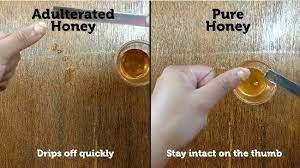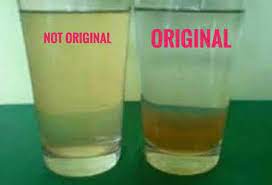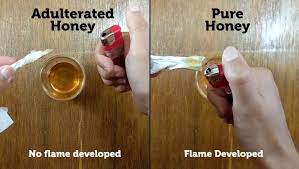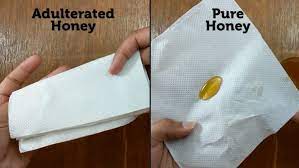
ADVERTISEMENT
Many of us might not recognize authentic honey and end up buying adulterated versions. Wondering how to tell the difference between genuine and fake honey? If you want to enjoy the full benefits of honey, it’s crucial to ensure its purity before purchasing. There are several simple tests and experiments that can be conducted at home to check the purity of honey. This article delves into these tests to help you identify real honey.
Identifying Pure Honey from Fake
Before performing any tests, start with a basic step: read the label on the honey jar before buying. Manufacturers are required to list any additives or preservatives added to the honey. To ensure a safe purchase, the honey should be free of added flavors or artificial substances.
Home Tests for Honey Purity
Thumb Test:

Place a drop of honey on your thumb. Check if it spreads or drips quickly. If it spreads rapidly, it’s likely adulterated. Pure honey should stay intact on your thumb.
Water Test:

Fill a glass with water. Add a spoonful of honey to the glass. Adulterated or artificial honey dissolves quickly. Pure honey settles at the bottom before stirring.
Flame Test:

Did you know pure honey is flammable? This test checks the absolute purity of honey. Strike a match and touch it to the honey’s surface. If the honey is fake, the match will light up and then quickly extinguish. Adulterated honey may contain moisture, one of the common impurities.
Vinegar Test:

Mix honey with water and a few drops of vinegar. If the solution becomes foamy, it indicates adulteration.
Paper Towel Test:

Pure honey, when contaminated with water, can be absorbed or leave damp residues on absorbent materials like blotting paper. Therefore, genuine honey should leave no wet traces on dry paper.
Ant Test:
Ants are attracted to adulterated honey due to its sugar content but not to pure honey. However, this test isn’t widely supported by evidence, and there’s no known reason why ants would prefer processed sugar over real honey.
Distinguishing Between 100% Pure Honey and Adulterated Honey
To enjoy the benefits of honey, purity is paramount. Due to high demand, some companies exploit this by selling adulterated honey, which may contain additives like glucose, dextrose, molasses, sugar syrup, corn syrup, starch, or other similar products.
Characteristics Comparison
Here are the key differences in honey’s properties that can help distinguish between real and fake honey:
| Test | Pure Honey | Adulterated Honey |
|---|---|---|
| Viscosity | Sticks without dripping when rubbed between fingers | Sticky due to additional sweeteners |
| Thickness | Thick, slowly moves from one side of the jar to the other | Not thick, easily flows |
| Taste | Flavor dissipates within minutes (Note: Heating and cooling can change the taste) | The added sugar prolongs the flavor |
| Smell | Fragrant | No smell or sour odor |
| Heat Effect | Caramelizes quickly without foaming | Bubbles, foams, and does not caramelize |
| Dissolution | Does not dissolve easily in water, settles at the bottom, and dissolves slowly when stirred | Dissolves in water forming threads, resulting in a cloudy solution |
| Flame Test | A match ignites easily when dipped in honey | Matches do not ignite easily due to moisture in adulterated honey |
| Bread Test | Hardens on a bread slice within minutes | Moistens and hydrates the bread slice due to water content |
| Absorption Test | Does not soak into paper towels, leaves no mark on white cloth | Soaks into paper towels, leaves marks on white cloth |
| Impurities | Contains impurities due to the presence of pollen | Lacks impurities |
Knowing these differences will help you appreciate and utilize honey’s full benefits while avoiding adulterated products.
Conclusion
ADVERTISEMENT
This revised version provides a clear and structured guide to identifying pure honey, making it perfect for readers seeking practical and reliable methods to ensure the quality of their honey.
Good information thank you
Thank you!
Thank you